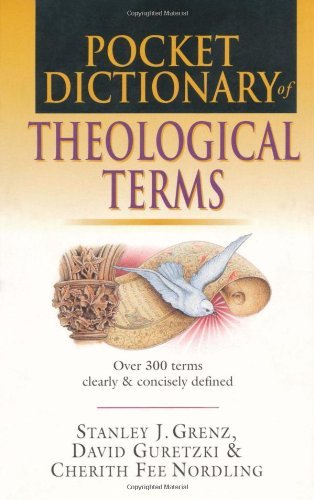Review: Pocket Dictionary of Theological Terms

A decent reference if you’re looking for an alphabetized listing of common theological parlance. Not so good if you’re looking for one uncolored by denominational agenda. IVP’s Pocket Dictionary of Theological Terms is exactly as the title suggests, but unfortunately its use as an educational tool is compromised by a pervasive gatekeeping mentality common in evangelical circles.
Early on, I came across this nacre of doctrinaire clumsiness:
If this is the kind of willful distortion coming down from the top in evangelical institutions, it’s no wonder why interfaith discourse is so heavily deformed in this country. The trinity of authors here have of course misdefined atheism.
Very few atheists say, “God definitely does not exist.” The vast majority say, “It’s unlikely that gods exist, and I see no good reasons for believing they do.” Just as most Christians don’t sashay around claiming Amun-Ra, Hermes, Zeus, Quetzalcoatl, or unicorns don’t exist, neither are most atheists in the business of making the positive claim that no gods exist. It’s just not something they concern themselves with, just as most people don’t concern themselves with belief in unicorns or other cryptids.
As many an atheist are wont to emphasize, positive disaffirmation is a spectrum’s length away from nonbelief. Most inclusively, then, atheism is simply the linguistic placeholder we use to denote the nonbelief in personal deities. Often enough, it is a conscious conclusion based on thoughtful consideration of the facts and evidence available.
Likewise, atheists do not necessarily have an ideological bias toward materialism. It’s just that the evidence to date seems to point to a material or entirely natural universe, an understanding of which isn’t bolstered by the postulation of hidden forces existing outside of it. To persuade a materialist to accept some form of dualism, supernaturalism, or paraphysical causality, advocates of those views would need to produce probative evidence, or at least a soundly reasoned case, in their favor. The burden of proof lies with those positing alternate dimensions of reality to demonstrate how their more expansive metaphysics improves upon current knowledge and understanding of the physical features of our world.1 At any rate, atheists are usually not in the habit of making universal or absolutist claims, but of simply voicing skepticism in the face of unchecked fanaticism.
Another area in which the authors’ doctrinal commitments seep through is in the various definitions connected to Christology (the nature of the Jesus of Scripture). One example is adoptionism:
If only it were so simple. Of course, in order to defend your favorite theology as “biblical” or “scriptural,” you have to advertise a univocal, monolithic view running throughout the Christian New Testament, a view which fails to hold up under any modicum of scrutiny or grasp of Christian history.
Examination of early Christian documents reveals that as stories about the historical Jesus developed, a diverse spectrum of thought began to take shape. The surviving exchanges and the manuscript tradition of the canonical gospels and other New Testament texts provide a window into these 1st-4th century conversations. The gospel narratives, for example, originated in different communities from different authors speaking to different issues to address different needs. These men had their own perspectives, their own experiences, their own concerns and desires, their own theologies. And this kaleidoscope of inspirations is what we see preserved in the Christian New Testament.
It should also be emphasized that none of the Greek writers thought they were writing (what was later to become known as) ‘Scripture’ or imagined that their writings would one day be canonized and subsequently compared, contrasted, and hyper-scrutinized alongside other period texts. How could they? Such foresight was alien to them. As we might expect, once these disparate texts were smashed together and consolidated many centuries later, the multivocality came along for the ride.2 Given this scenario, it should not be surprising in the least that the gospel writers, in several respects, did not agree with each other; they expressed different views about Jesus, God, and the linkages therein.
As a result, adoptionist Christologies, widespread in early Christian thought, along with docetic and separationist Christologies and others, all made it into the eventual Bible. Moreover, when we compare later manuscripts with earlier manuscripts, we find dozens of examples of where those holding anti-adoptionist, anti-docetic, anti-separationist perspectives, and everything in between, altered the words in an effort to bludgeon the texts into an artificial conformity.3 (Ostensibly, antiquity’s concern for internal harmony was anticipatory of modern-day evangelicals.) Were it not for this diversity of voices, there would have been no motivation to amend the texts in the first place.
To recap, where did this mishmash of views come from? They originated with the texts — and any associated oral tradition from which they derived — ideological dissimilarity notwithstanding. Because the New Testament documents, taken together, are inconsistent, conflicting, and contradictory on several matters of theological importance, of course there are passages in one book which suggest against adoptionism, just as there are passages in others which gesture toward adoptionism. This is what happens when you consolidate texts from different authors. For this reason, doctrine is ultimately best organized by text, not by denomination.
This is also why prooftexting — mining for verses in an effort to extrapolate a biblical-wide perspective — is irretrievably flawed in approach. Pointing to passages like 2 Timothy 3:16 or 2 Peter 1:20-21 as denoting biblical ‘infallibility’ or ‘divine inspiration’ is a naïve and dishonest way of using the Bible to validate theological beliefs. How could the authors of one text make any claim for texts that had not yet been written and for texts they had no clue would one day accompany their own? Nowhere in the Bible does it mention which books it should include (its authors had no forethought of ‘canon’).
Prooftexting thus fails as a hermeneutical device, not least because you are using the words of one author to interpret the words of another, while papering over the local context within the text itself — i.e., the specific purpose for which the author is writing — all while ignoring the complex, arduous, and interesting history of the formation of the biblical canon, itself the product of a long line of human decisions. There can be no substitute for, and no escape from, working out meaning and context for oneself given the vast trove of resources at our disposal today.
Closing Thoughts
Instead of suppressing these facts or deeming them a problem, those in thrall to evangelical tradition might try accepting the Bible for what it is instead of forcing it to be something it isn’t. The Bible isn’t a book, it’s a library (the very word ‘Bible’ means “library”). And hence contrary to the reflexively tendentious language plastered up and down this handy dictionary, the Bible is not an ideological monolith. It contains a wealth of competing ideas and mutually exclusive viewpoints. That such diversity of voice and dialectic tension were preserved demonstrates that the editors of the biblical texts were not overly concerned with conveying a single, consistent message or doctrine.
To push against this fact is like a library patron complaining that something she read in a book from one part of the library contradicts something she read in a book from another part of the library. We would probably question this person’s mental maturity. Just as we expect to see different perspectives from books of different genres written by different authors at different times in different places for different purposes, so we should not be surprised or otherwise disturbed by the presence of discrepancies and inconsistencies in the biblical texts. Like so much of evangelical scholarship, this resource is contaminated with theological insularity. Gatekeeping in dictionary form.
Note: This review is mirrored over at Goodreads and at Amazon.
Feature image credit: mick_pattison
- This is a sensitive point and one that merits further unpacking. The value of natural vs. non-natural explanation is a topic that has been dissected by a number of scientific greats over the years, and my personal favorite treatment can be found in Carl Sagan’s The Demon-Haunted World: Science as a Candle in the Dark (1995). In it, he recalls how every aspect of the universe was once ascribed to supernatural causality (e.g., witches inflicted particular illnesses with their spells; rain was a divine reward, drought a divine punishment; the “rising” and “setting” of the sun was controlled by the whims of the neighborhood deity; short-period comets presaged the fall of state empires, etc.).
But then we learned the principles of infectious disease, how Newton’s laws of motion govern planetary patterns. We learned that the right medicine can cure an illness. And this changed everything. Because if an illness was caused by the spell of a witch, for instance, there is no reason to think we should find a natural cause for it, nor is there any reason to think we should find a natural cure. But in fact, it turned out that the right remedy could always overcome the power of “magic spells.” Supernatural explanations were henceforth rendered unnecessary, superfluous. And to date, there’s not one component of reality that’s needed one yet.
Thus, far from an a priori rejection of supernaturalism, science’s preoccupation with methodological naturalism is borne out of an extensive and storied history of displacing and supplanting supernatural conjecture with natural causality. This has been a unidirectional process. Sagan puts it this way:
“…Again, we know a great deal about the existence and properties of matter. If a given phenomenon can already be plausibly understood in terms of matter and energy, why should we hypothesize that something else—something for which there is as yet no good evidence—is responsible? Yet the complaint persists: Skeptics won’t accept that there’s an invisible fire-breathing dragon in my garage…” (p. 301)
These concepts are deeply critical to understanding the origins, methodology, and overwhelming success of science throughout history.
[↩]
- This idea could be reduced to a simple maxim: Canonization (or consolidation) begets multivocality.
[↩]
- Scribal variations were not confined to issues of Christology, either. The copyists, and those managing Christian scriptoria, were not insulated from the social conflicts of their day, such as the role of women in the church, Christian ties and opposition to Jews, theological distancing from pagans, and the like. And thus we also see a number of redactions and other emendations related to each of these concerns when comparing the manuscript evidence. For more, see Bart D. Ehrman’s Misquoting Jesus: The Story Behind Who Changed the Bible and Why, The Orthodox Corruption of Scripture: The Effect of Early Christological Controversies on the Text of the New Testament, and Lost Christianities: The Battles for Scripture and the Faiths We Never Knew.
[↩]



Comments